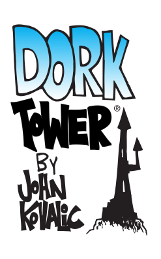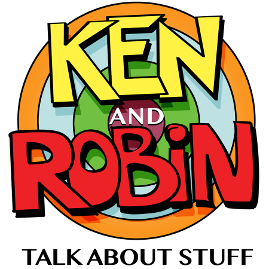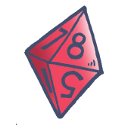Episode 50: Lasers and Moog Synthesizers
August 2nd, 2013 | Robin
 We flip through some pages in the Gaming Hut as we discuss the evolution of roleplaying game graphic design, from aesthetics to utility.
We flip through some pages in the Gaming Hut as we discuss the evolution of roleplaying game graphic design, from aesthetics to utility.
Then we slip into the plush seats of the Cinema Hut to review the career of the great Hong Kong director Johnnie To. His latest masterpiece, Drug War, awaits a North American cinema release in August.
In Ask Ken and Robin, Chris Shorb asks if Robin’s Laws of Good Gamemastering is still relevant today.
Then the neglected dials of Ken’s Time Machine finally get twiddled as he heads back to the 15th century to save Joan of Arc.
Podcast: Play in new window | Download















I can’t wait for the “Okie’s” Zoom from KWAS
What is the eliptonic significance of this giant pentagram in Kazakhstan http://www.livescience.com/38623-giant-pentagram-in-kazakhstan.html
Regarding RPG graphic design: Be it resolved that the “For Dummies” books represent a paradigm of text layout to which all game texts should aspire? Let’s discuss.
As Robin points out, a rulebook must succeed at the somewhat crossed purposes of being engaging upon first read, and a useful reference volume thereafter.
Atmosphere and flavour are best conveyed through prose (and images), as are explanations. For reference, rules and game mechanics should be set apart (or ideally, repeated) in point form, boldface, tables or sidebars.
If I may presume to criticize Trail of Cthulhu for a moment (it being the game text that I’ve most recently read), I often find myself scanning through paragraphs of prose looking for rules (e.g. Contests, casting spells), or trying to reference rules sets that are spread cross several sub-sections (e.g. losing and recovering Health and Stability).
Looking at layout at a larger scale, I’ve never understood the tendency to start a game text with the complete rules for character creation. Most RPG books do it. This has the neophyte reading about the minutiae of buying skill points and selecting abilities before she even knows what the game is about! Although true that generating characters is one of the first phases of game play, a new prospective player wants to start with a more general introduction to the game. One approaches a new game with the questions “what is this game about and do I want to play it?” What do the players do (to quote Robin again), what are the mechanics like, and so on. The typical one-page introduction before diving into stat’ting up a character is simply insufficient. I often find myself reading a new RPG starting with the “For The GM” section, or the included introductory scenario.
In the art of laying out RPG rulebooks for engagement and utility, I think there remains a lot of room for improvement and innovation. I wonder if it would be useful to workshop game texts themselves, separately from the play-testing of the actual games.
Thank you John Wilson for articulating what I didn’t even realize I did subconsciously. This in fact happened most recently when I was looking at Pelgrane’s own 13th Age at my FLGS. And this was a game I had heard a lot about and even listened to an AP Podcast or two. And still I was trying to get a sense of how it played. Best thing I found in a quick glance was at the end of the combat section an example of combat.
One good thing in Fiasco is the “actual play” section that comes after the rules.
Wouldn’t it be great if something like this was there at the very beginning, with annotations to the relevant sections:
“Bolg the Barbarian hits the Orc, cleaving through his armor and slicing off his arm” (see p56 for Barbarian, see p245 for Orcs, see p156 for combat, see p 178 for damage).
And of course in pdf format, simply have things be hyper texted. Done right, and with judiciousness, this could be very useful.
Thanks by the way for using my question, the book is sitting in my reading pile for re-reading. It may move up if the possibility of my actually running a game soon rears it’s head again.
Robin, your offhand comment about taking a flat fee for Robin’s Laws left me wondering – what are other options creators can take – and what is common in the game industry? What is uncommon, or rare, or unheard of? I’d find it especially entertaining to hear how deals in gaming compare to deals in other industries. Not simply in scale, although I’m pretty sure even Monte Cook’s payday from Numenara pales compared to what Jackie Chan gets paid per picture…
Congratulations on 50 episodes.
Another issue to consider with the layout is the suitablity of the text on tablets. While Hillfolk may look nice in print, I find reading the pdf on my iPad quite difficult. When displaying a full page (and even when cropping some of the margins) I find the font of the rules text just a bit too small and to light to read, while the less playful font of the additional settings is much more pleasing to the eye (of course it is possible to zoom the text, but that completely defeats the purpose of graphic design).
Agreed, Ralf – I’ve got a Nook that I read pdfs on, and getting through Hillfolk was a bit of a slog with having to swing through the page to find the next column. I wouldn’t mind a normal page sized pdf to read Hillfolk on, although I doubt one will happen.
My notes on this episode are pretty old, so I may not have gotten everything.
Bibliography
Books:
Mark Bittman – How to Cook Everything
Robin D. Laws – Robin’s Laws of Good Gamemastering
John Steinbeck – The Grapes of Wrath
Movies:
All About Ah-Long by Johnnie To
The Bourne Ultimatum by Paul Greengrass
Breaking News by Johnnie To
Don’t Go Breaking My Heart by Johnnie To
Drug War by Johnnie To
Election by Johnnie To
Election 2 or Triad Election by Johnnie To
Everlasting Regret by Stanley Kwan
Exiled by Johnnie To
Eye in the Sky by Johnnie To
The Godfather Trilogy by Francis Ford Coppola
Goodfellas by Martin Scorsese
The Heroic Trio by Johnnie To
Life Without Principle by Johnnie To
The Mission by Johnnie To
The Passion of Joan of Arc by Carl Theodor Dreyer
The Player by Robert Altman
PTU by Johnnie To
Running Out of Time by Johnnie To
Sparrow by Johnnie To
To Catch a Thief by Alfred Hitchcock
Triangle by Johnnie To
Where a Good Man Goes by Johnnie To
Yesterday Once More by Johnnie To
Directors Mentioned:
Luc Besson
Wang Kar Wei
Jean-Pierre Melville
Howard Hawks
I think that if you want to investigate the evolution of graphic design in the adventure games industry, you almost have to start with Redmond Simonsen. His work on a decade of SPI’s products (along with Jim Dunnigan’s very strong technical writing and design skills) set a standard for clarity and understandability that I think has not been met regularly by anyone since.
Simonsen’s ability to put information on a 5/8″ counter while still creating an interesting game piece was simply phenomenal. His game maps (with required tables were models of clarity, and his rules layout included good contextual information without obscuring the actual rules.
And this wasn’t purely used on hex and counter wargames, of course. Both DragonQuest (originally Dragon Slayer) and Universe were quite graphically strong. (Compare them to the basically contemporaneous first edition of AD&D or Ruequest, for instance.)
Much of what game designers take as obvious today had its roots in Simonsen’s designs.
Robin’s Laws of Good Gamemastering was the first book that firmly fixed your name in my head. I still pull it out for a quick reread every year or so, just as a refresher course.